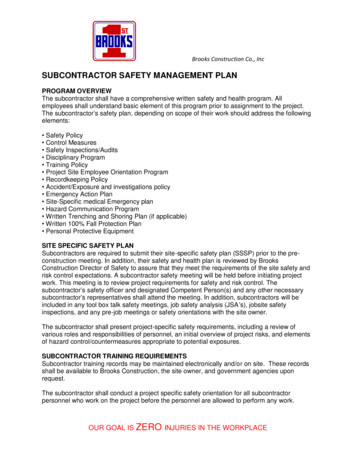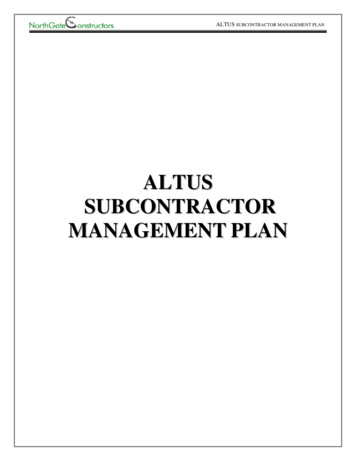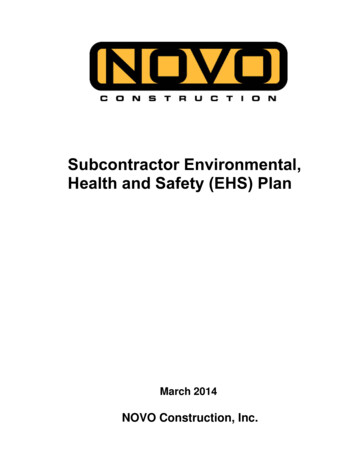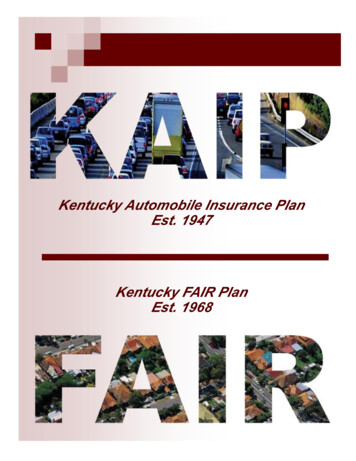
Transcription
Provided by: Thor Insurance & Registries LtdN/A Tofield, AB T0B 4J0Tel: 855-662-34651 SUBCONTRACTOR MANAGEMENT PLAN 2015 Zywave, Inc. All rights reserved.
Table of ContentsIntroduction.3Prequalification and Bidding Process .4Insurance Considerations.6Beginning Work .9Work Site’s Written Safety Plan .11Safety Training and Recordkeeping Policies.13Safety Inspections .15Work-in-progress and Post-project Reviews .212 SUBCONTRACTOR MANAGEMENT PLAN
IntroductionA Subcontractor Management Plan (SMP) outlines the relationship between contractors while they areperforming work for a certain project, and it outlines the methods by which the primary contractor willensure the production of quality deliverables from each of its subcontractors and ensure the developmentof long-term business relationships between the companies.Please note that this plan contains key components that should be considered when drafting an SMP.This guide is not all-inclusive and certain areas may not apply to your contract. Also, include othercomponents or areas pertinent to your contract.Although the procurement person prepares the SMP, it is vital that the SMP contain the input of othermembers of the contract management team to ensure that existing issues, vulnerabilities and risks areadequately addressed. Consequently, the SMP draft should be routed for input through members of thecontract management team.This SMP provides guidance for subcontract management activities, including the following:Prequalification and bidding processInsurance considerationsBeginning workWork site’s written safety planSafety training and recordkeeping policiesSafety inspectionsWork-in-progress and post-project reviewsThe information contained in this toolkit is not intended to be used as legal advice. The reader shouldconsult legal counsel regarding specific legal issues.3 SUBCONTRACTOR MANAGEMENT PLAN
Prequalification and Bidding ProcessPrequalifying subcontractors is an important way to ensure the hiring of a subcontractor that has thenecessary experience and the ability to complete the job safely, on time and within the budget. While notmandatory, prequalifying a subcontractor helps minimize risk and increases the chance of the job beingdone right. Consider the following when going through the prequalification process.Gather the subcontractor’s qualifications, whether through a questionnaire, formal written request,qualification statement or other method. Examine the following information:oDoes the subcontractor have experience completing similar work?oDoes the subcontractor have the necessary resources (manpower, finances, availableequipment, insurance and surety bonding capacity, licensing, etc.) to complete the job?oDoes the subcontractor have a history of litigation or other legal problems?oDoes the subcontractor have any past OH&S violations?oDoes the subcontractor’s safety record prove that the job can be done in a safe manner?oDoes the subcontractor have any references from previous contracts? Were pastcustomers satisfied with the subcontractor’s work?Prequalification should let a potential bidder know exactly what to expect from project start tofinish. Giving a bidder every piece of relevant information, along with being available to answerany questions he or she might have, will make the process fair and objective.Not all subcontractors will qualify for the bid. To weed out bids that fall short of your standards,consider implementing minimum requirements for the subcontractor, such as making sure thesubcontractor:oHas not been nor is currently debarred by any federal, provincial or local governmentauthority in the past X yearsoHas not defaulted on any project in the past X yearsoHas not had any professional licence revoked in the past X yearsoHas not committed a serious or wilful OH&S or other federal or provincial safety violationin the past X yearsAfter a list is compiled of qualified bidders, bids can be submitted. Generally, qualified bidders with thelowest bid will be selected for the contract, although this is not always the case. The lowest-bid contractsdo not always ensure that a project is completed on time within the stated budget. Lowest-bid contractstend to have more change orders throughout the process, increasing the overall cost of the contract andoften causing delays and broken deadlines. Thorough examination of a subcontractor’s qualifications andthe proceeding bid, if reasonable, should both be taken into consideration before selecting asubcontractor for the job.4 SUBCONTRACTOR MANAGEMENT PLAN
Prior to awarding the contract to a qualified bidder, the primary contractor or owner should document:The proposed project schedule that includes key milestones and a description of the technicalapproach to the project;The project management team that includes, at a minimum, the construction management, fieldsupervision and technical personnel. With the project management team list, resumes of thepeople listed may be included;A quality control plan that includes a copy and/or description of the quality control program to beused on the project and any implementing documents applicable to its program; andA cost control plan that includes a description of the cost control program being used for theproject.5 SUBCONTRACTOR MANAGEMENT PLAN
Insurance ConsiderationsCertificate of InsurancePrior to the beginning of the project, the subcontractor should provide two certificates of insurance to theprimary contractor showing that the subcontractor has coverage for him- or herself and his or heremployees, agents and subcontractors. All coverage must be placed with insurance companies dulyadmitted in the province or in the desired licensing jurisdiction in which the work is being done, and allcoverage must be reasonably acceptable to the primary contractor. Speak with your Thor Insurance &Registries Ltd representative to obtain certificates of insurance and verify the subcontractor is adequatelycovered.The certificates of insurance should provide that the insurer give the contractor a written notice ofcancellation and termination of the contractor’s coverage at least 30 days prior.Additional InsuredsThe subcontractor’s policy must name the contractor as an additional insured. Coverage must be affordedto the contractor as an additional insured whether or not a claim is in litigation. Additional insuredcoverage must apply as primary insurance with respect to any other insurance afforded to the owner andcontractor.Insurance Coverages Subcontractors Should PossessCommercial general liability (CGL)Subcontractors should secure a CGL insurance policy to cover the damages that become due incase of bodily injury, property damage and personal or advertising injury arising out of or relatedto:oAll of the subcontractor’s operations and premises;oAll of the subcontractor’s products and completed operations;oAll liability or responsibility assumed by the subcontractor;oAll liability assumed in a business contract;oThe contractor as an additional insured; andoDefence expenses paid in addition to the policy limits.There should be no endorsement or modification of the CGL for risks arising from pollution,explosion, collapse, underground property damage or work performed by the subcontractor.Auto liabilityThe subcontractor should secure an automobile liability insurance policy to cover the damagesthat become due in case of bodily injury, death of a person or property damage arising out ofownership, maintenance or use of any motor vehicle or trailer owned, hired, leased, used onbehalf of or borrowed by the subcontractor. The policy must also include coverage for any6 SUBCONTRACTOR MANAGEMENT PLAN
equipment subject to motor vehicle laws, contractor and owner (if different than the contractor)and any subcontractor liability or responsibility.Umbrella or excess liability coverageThe subcontractor should secure an umbrella liability insurance policy to cover the damages thatbecome due in case of bodily injury, property damage and personal and advertising injury, with atleast the same terms and conditions as the policies mentioned above.Completed Operations Liability and ObligationsEven quality workmanship is not immune to potential claims of property damage or bodily injury. Alloperations carry the risk that injury or damage may occur as a result of the work, leading to costlylawsuits. Considering the complicated mix of contractors and subcontractors that contributes to eachproject, who is liable for this risk?In insurance terms, “your work” as used in an insurance policy is a broadly defined term that includesoperations performed by the policyholder or on the policyholder’s behalf, including material, parts orequipment in connection with the operations. Operations or work performed on behalf of the policyholdermeans work done by a subcontractor is considered the contractor’s work. Therefore, faulty electrical workperformed by an electrician that causes a fire or other damage could be considered the contractor’sliability, but would be covered under a standard CGL policy.Because a contractor or other involved party could be held liable for defects in a subcontractor’s workyears after it has been completed, filing the claim under the contractor’s CGL policy could cause thepremium to rise. Many construction contracts require subcontractors to provide insurance coverage forclaims resulting from their completed work for a finite period of time, typically the one- to five-year range.Typical contracts also require that the subcontractor name the owner, the architect, the general contractorand other third parties as “additional insured” parties, who are entitled to coverage under the insuredsubcontractor’s CGL policy. Naming additional insured parties requires a separate endorsement to thatpolicy.This means that subcontractors can be held liable for claims of property damage or bodily injury resultingfrom a defect in a contractor’s work. It is also critical to maintain this coverage into the future; failure to doso could lead to a breach-of-contract lawsuit brought by the contractor or other party.It is important for subcontractors to understand this commitment when signing the contract—theinsurance commitment doesn’t end with the project. Further, in the event of a large claim, subcontractorscould be faced with a substantial increase in premiums on the policy.What can subcontractors do to reduce the risk of a claim being filed against them for a defect in theircompleted work? To avoid litigation, it is crucial to know local regulations and adequately documentproper performance. Subcontractors must know their company’s documentation practices relative to eachsubcontract, and carefully keep records of all processes.7 SUBCONTRACTOR MANAGEMENT PLAN
Beginning WorkAfter a subcontractor has been selected, each subcontractor should have a legally binding, writtencontract that defines the following items:The legal names of the parties involved in the contractThe scope of the contracted work (contained in an attached statement of work (SOW)), whichshould include the following items:oEach subcontractor’s clearly defined responsibilities and authoritiesoEach subcontractor’s deliverables identified, and required content clearly specifiedoEach subcontractor’s clearly identified and described services that it is responsible forprovidingoSchedule and budget constraintsoEach subcontractor’s clearly defined requirements for quality, including the requirementto allow independent quality inspections of materials and processesoAppropriate terms and conditionsoAdequate facilities provided to meet the needs of the subcontractorsoThe primary contractor’s support in processing invoices and paymentsThe appropriate terms and conditions that will be imposed on both the primary contractor and thesubcontractorAn acceptance processGeneral Subcontractor ManagementManaging various subcontractors and their teams can be a difficult task, but successful projects all tendto have the same characteristics:They all have clear and unambiguous subcontracts established that include an SOW.The efforts of all subcontractors are integrated into a cohesive project plan with all subcontractorsunderstanding where their efforts fit into the overall picture.The formal and informal interfaces between the primary contractor and the subcontractors, aswell as among the subcontractors, are documented.Before starting specific work, the subcontractors are granted authorization to proceed. Thisauthorization is given, in writing, via a Work Authorization form.A formal team building process is established and implemented.These practices all contribute to reducing the risk of misunderstandings or isolationism.The work of all subcontractors should be coordinated by the primary contractor to ensure that the efforts8 SUBCONTRACTOR MANAGEMENT PLAN
For full access version, please contact us.Contact InfoThor Insurance & RegistriesThor FinancialPO Box 299, 324 50th St.450 Ordze RoadTofield, AB, T0B 4J0Sherwood Park, AB, T8B 1C9Phone: 1(855)-662-3465Email: tjones@thorinsurance.ca
A Subcontractor Management Plan (SMP) outlines the relationship between contractors while they are performing work for a certain project, and it outlines the methods by which the primary contractor will ensure the production of quality deliverables f










